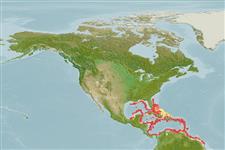Common names from other countries
>
Scombriformes (Mackerels) >
Gempylidae (Snake mackerels)
Etymology: Neoepinnula: Greek, neos = new + Latin ex = outside + Latin, diminutive of pinna = spiny (Ref. 45335).
Environment: milieu / climate zone / depth range / distribution range
Ecologia
marinhas bentopelágico; intervalo de profundidade 184 - 457 m (Ref. 6181). Deep-water; 31°N - 3°N, 94°W - 49°W (Ref. 6181)
Western Atlantic: known only from the Gulf of Mexico, Yucatán Channel, Caribbean Sea off Venezuela, off Suriname, and off southern Brazil (Ref. 47377).
Tamanho / Peso / Idade
Maturity: Lm ? range ? - ? cm
Max length : 22.0 cm SL macho/indeterminado; (Ref. 6181)
Espinhos dorsais (total) : 27; Raios dorsais moles (total) : 17 - 20; Espinhos anais: 3; Raios anais moles: 17 - 20. There are two lateral lines on the sides, both originating above the upper angle of the gill opening. Sometimes the lower lateral line branches off from the second or third tubular scale of the upper lateral line. The sides are silvery, the back brown; the first dorsal fin is blackish, the second dorsal fin black anteriorly; the buccal cavity is pale, and the branchial cavity pale to dusky.
Life cycle and mating behavior
Maturities | Reprodução | Spawnings | Egg(s) | Fecundities | Larvas
Nakamura, I. and N.V. Parin, 1993. FAO Species Catalogue. Vol. 15. Snake mackerels and cutlassfishes of the world (families Gempylidae and Trichiuridae). An annotated and illustrated catalogue of the snake mackerels, snoeks, escolars, gemfishes, sackfishes, domine, oilfish, cutlassfishes,. scabbardfishes, hairtails, and frostfishes known to date. FAO Fish. Synop. 125(15):136 p. (Ref. 6181)
Categoria na Lista Vermelha da IUCN (Ref. 130435)
CITES (Ref. 128078)
Not Evaluated
Ameaça para o homem
Harmless
Utilização humana
Ferramentas
Relatórios especiais
Descarregue XML
Fontes da internet
Estimates based on models
Preferred temperature (Ref.
115969): 9.9 - 19.6, mean 16 (based on 46 cells).
Phylogenetic diversity index (Ref.
82804): PD
50 = 0.7500 [Uniqueness, from 0.5 = low to 2.0 = high].
Bayesian length-weight: a=0.01023 (0.00426 - 0.02456), b=3.00 (2.80 - 3.20), in cm Total Length, based on LWR estimates for this (Sub)family-body shape (Ref.
93245).
Nível Trófico (Ref.
69278): 3.8 ±0.5 se; based on size and trophs of closest relatives
Resiliência (Ref.
120179): Elevada, tempo mínimo de duplicação da população menor que 15 meses (Preliminary K or Fecundity.).
Fishing Vulnerability (Ref.
59153): Low vulnerability (17 of 100).
